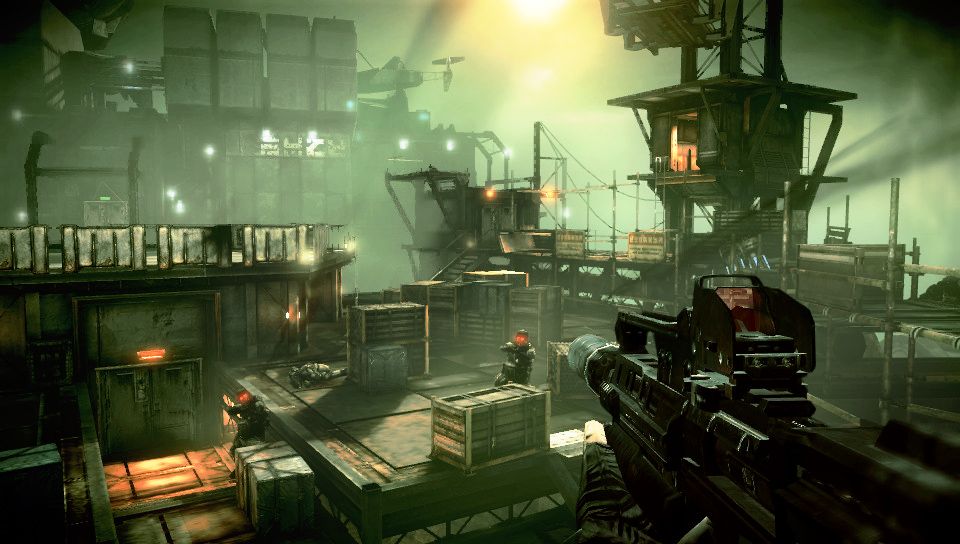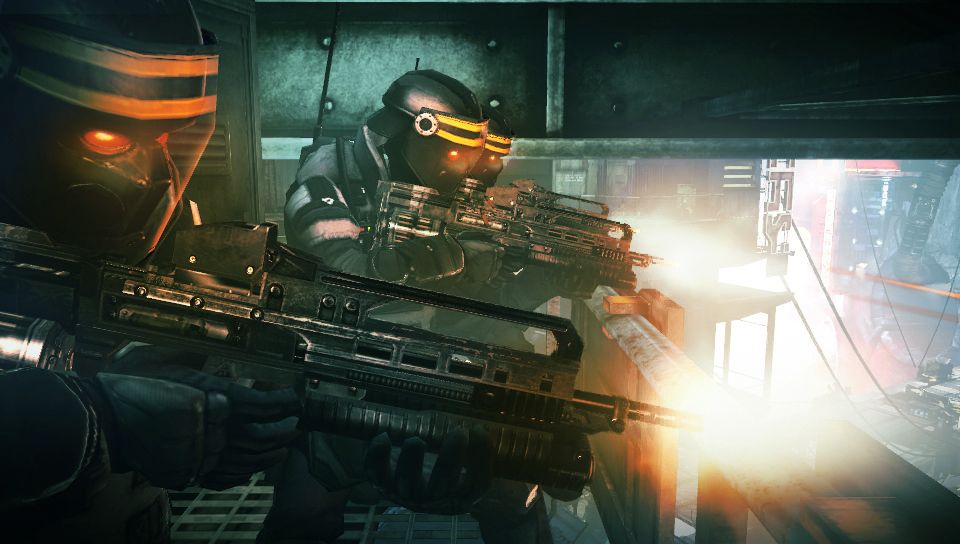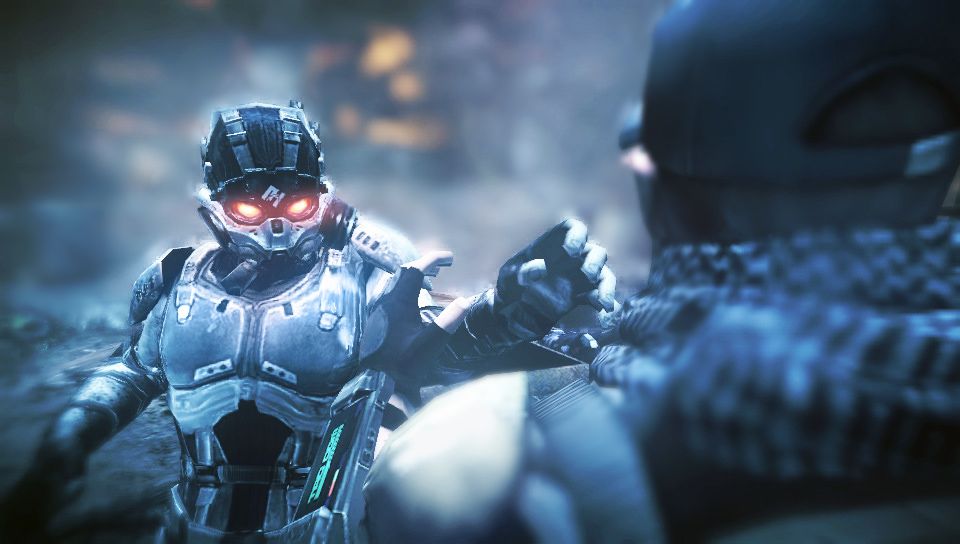When I think of first-person-shooters on PlayStation Vita, the image of a cinematic, enthralling, and console-quality experience is not what appears in my head. Rather, I see bite-sized missions, cramped gameplay, and artistic compromises. Killzone Mercenary has none of these things. After hands-on time with Guerrilla Cambridge’s offshoot of the blockbuster PlayStation 3-exclusive franchise, I can tell you that Killzone Mercenary is quintessential Killzone. With powerful weapons, weighty movement, and all the makings of a thrilling war epic, Killzone Mercenary looks poised to take PS Vita by storm as not only the first good PS Vita FPS, but the system’s first true benchmark.
Guerrilla claims that Killzone Mercenary was designed from the outset to mirror the visual fidelity and unyielding immersion of its console ilk. After playing through an early section of the game, I can confirm that both claims hold true. Running on a slightly-downscaled version of the Killzone 3 engine, Mercenary impresses with dynamic lighting, stunning aesthetic, and a myriad of post-processing effects. The result is a game that, at first glance, looks arguably on par with Killzone 2. Closer inspection reveals textures with a bit less detail, but I’m stunned by what PS Vita’s processing horsepower can output as I boot up the demo level.
The level in question is the game’s second mission. As Phantom Corp PMC soldier Arran Danner, I touch down on the surface of Helghan. As a mercenary – a contract killer – Danner’s allegiance lies with the highest bidder, and in a war situation as crucial as this one, it just so happens that the ISA is tossing the most dollars. Killzone veterans will recognize the situation immediately; Danner leaps from a Vektan cruiser, opens the flaps on his wingsuit, and flies down through clouds that part to reveal a cataclysmic beachhead. It’s eerily reminiscent of Killzone 2’s opening scene, and for good reason: Danner’s mission is to secure the same beachhead that the ISA will use to begin its assault on Helghan, mere hours later.
As the mission begins, my superiors contact me via radio. My partner-in-arms for this mission has crash-landed somewhere off-site, and the decision is passed down to abandon him in pursuit of my mission objectives. I can’t help but agree; as I take my first few steps forward, the urge to slay the first Helghast who dares cross my path is powerful. I barely have time to familiarize myself with the game’s controls before that very thing happens. For the first time, I’m able to experience the thrill of combat in Killzone Mercenary, and I have nothing but good things to report.
You see, the control scheme and combat gameplay of Killzone 3 is more-or-less ported in full. I can crouch with the Circle button, sprint by pushing Circle while moving forward, aim down my sights with L trigger – every function you expect (and need) from a Killzone game is here. Vita’s touchscreen enters the equation where it makes sense – you must tap icons on the screen’s right edge to switch weapons and bring out your equipped grenade, while screen swipes aid the same brutal melee kills that made gamers squeal in Killzone 3. Much like the series’ second installment, movement feels quite weighty, but gunplay retains the hyper-responsiveness of Killzone 3. To me, it’s the perfect mix – I loved the immersion induced by Killzone 2’s gravity, but appreciated the refined shooting mechanics of 3. I’m elated to report that Mercenary is the best of both worlds.
As I gun down Helghast soldiers in pursuit of mission objectives (including Arc Cannons that must be hacked), the intense level of enemy intelligence becomes apparent. These are the Helghast soldiers you recognize, dodging and weaving between pieces of cover, flooding your position with grenades, and flanking with unmatched zealotry. My only option for survival seems to be Marty’s Engine, one of eight VAN-GUARD deployable ….. that takes the form of a flying drone I control in first-person. It’s a brilliant piece of machinery, and with some level of precision, I pilot the drone to a turret nest that’s giving me trouble. As I press the R trigger, two ultra-large, ultra-scary blades of death stab my Helghast adversary through the neck. Yep, this is Killzone, and I couldn’t be happier with my blade-armed drone friend and its ruthless efficiency.
As I move through tiers of industrial zones and interiors, I take note of the mostly-stable framerate that keeps the action moving despite unprecedented levels of chaos. Guerrilla’s attention to environmental detail is stunning, and it’s easy to lose myself in the heat of the war-torn moment. My efforts are soon aided by the arms dealer Blackjack, who supplies mercenaries like myself with vending crates where our hard-earned cash can be spent on weapons, equipment, perks, and VAN-GUARD deployables. In Killzone Mercenary, you earn currency for many things (kills, headshots, scavenging ammo, etc.), and that bank of funds is shared between the single- and multi-player experiences. I must not be a good mercenary, as I haven’t earned enough money to buy a new rifle, so I continue on with renewed vigor.
Mere minutes later, my demo of Killzone Mercenary ends, and I’m left to ruminate on the experience. My feelings are not wholly positive – without AI partners or much combat dialogue, my time with the game lacked some of the cinematic urgency that shared a part in making its console predecessors so compelling. Marty’s Engine also felt a bit overpowered – I easily killed seven or eight Helghast before disconnecting the drone of my own volition, and I seemed to take no damage in the interim. These are both concerns that Guerrilla Cambridge has plenty of time to address before Mercenary’s September 17 release date, and I have little reason to doubt a company with such an astounding PlayStation pedigree. Killzone Mercenary looks to be PS Vita’s first truly compelling console-quality FPS, and I couldn’t be more excited.


